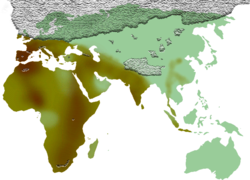
Movius Line
Encyclopedia

India
India , officially the Republic of India , is a country in South Asia. It is the seventh-largest country by geographical area, the second-most populous country with over 1.2 billion people, and the most populous democracy in the world...
first proposed by the American archaeologist Hallam L. Movius
Hallam L. Movius
Hallam Leonard Movius was an American archaeologist most famous for his work on the palaeolithic period.He was born in Newton, Massachusetts and became a professor of archaeology at Harvard University in 1930...
in 1948 to demonstrate a technological difference between the early prehistoric tool technologies of the east and west of the Old World
Old World
The Old World consists of those parts of the world known to classical antiquity and the European Middle Ages. It is used in the context of, and contrast with, the "New World" ....
.
Movius had noticed that assemblages of palaeolithic stone tools from sites east of northern India never contained handaxes and tended to be characterised by less formal implements known as chopping tool
Chopping tool
In archaeology, a chopping tool is a form of prehistoric stone tool, considered to be a refinement of the earlier chopper.Unlike the crude chopper, the chopping tool is created by removing flakes from two sides of a lithic core...
s. These were sometimes as extensively worked as the Acheulean
Acheulean
Acheulean is the name given to an archaeological industry of stone tool manufacture associated with early humans during the Lower Palaeolithic era across Africa and much of West Asia, South Asia and Europe. Acheulean tools are typically found with Homo erectus remains...
tools from further west but could not be described as true handaxes. Movius then drew a line on a map of India to show where the difference occurred, dividing the tools of Africa, Europe and Western and Southern Asia from those of Eastern and Southeastern Asia.
Fossil evidence also suggests a difference in the evolutionary development of the people who made the two different tool types across the Movius Line and it has remained in use as a convenient distinction between the two traditions. The existence of the line, both in terms of stone tool technology and human evolution has needed to be explained.
Theories to explain the existence of the Movius Line include the idea that perhaps the ancestors of the toolmakers who settled in eastern Asia left Africa before the handaxe was developed. Alternatively the settlers moving to Asia may have known how to make handaxes but passed through a 'technological bottleneck', that is a region where suitable materials to make them were lacking. The skills were thus forgotten and isolation by distance meant that the knowledge was never re-introduced.
An alternate theory states that rather than stone axes, early humans in east Asia used bamboo tools instead.
Exceptions
At first, New archaeologic evidence from Jeongok-ri, South KoreaSouth Korea
The Republic of Korea , , is a sovereign state in East Asia, located on the southern portion of the Korean Peninsula. It is neighbored by the People's Republic of China to the west, Japan to the east, North Korea to the north, and the East China Sea and Republic of China to the south...
shows that there are also handaxe in eastern Asia.
New archaeologic evidence from Baise, China
China
Chinese civilization may refer to:* China for more general discussion of the country.* Chinese culture* Greater China, the transnational community of ethnic Chinese.* History of China* Sinosphere, the area historically affected by Chinese culture...
shows that there are also handaxe in eastern Asia.

